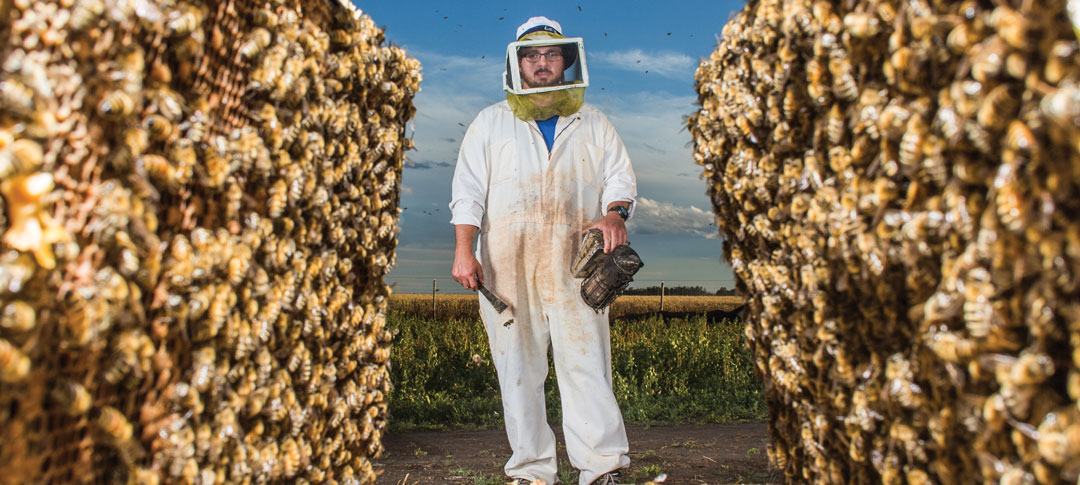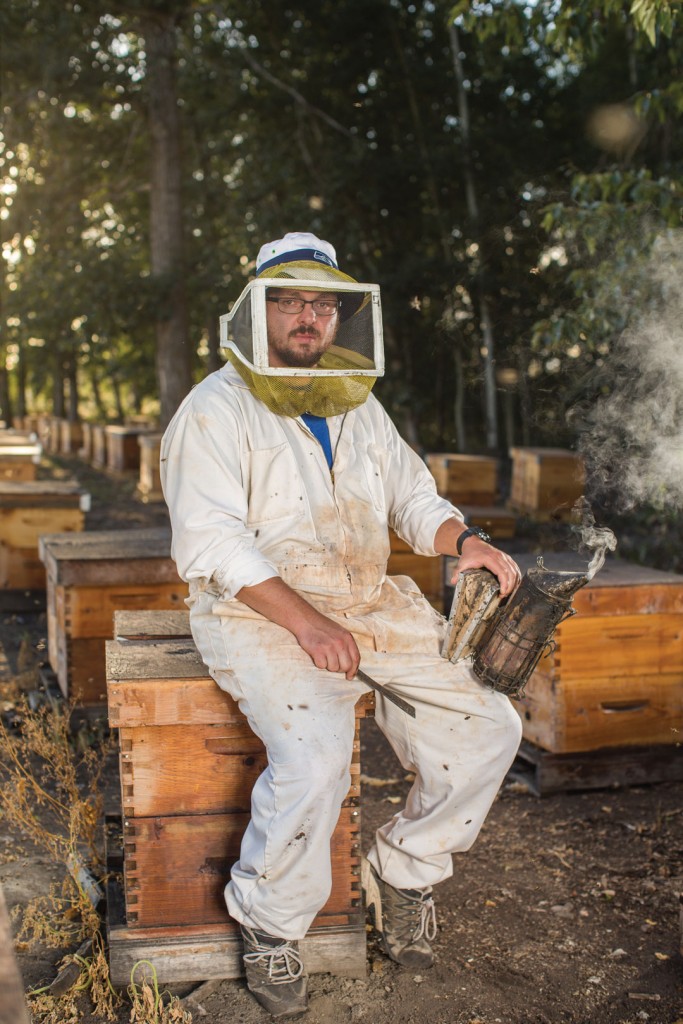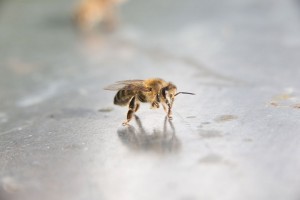POLLINATOR POLEMICS
BEE HEALTH AND THE NEONICS DEBATE IN ALBERTA AND ONTARIO
BY CULLEN BIRD
It was the morning of April 18, 2012, when Davis Bryans, owner of Munro Honey, was told something was wrong with one of his bee yards in Sarnia, ON. A few hours earlier the bees had been busily foraging, but now there was a pile of them sprawled on the ground in front of the hives.
Some were twitching. Others were already dead. Across the road, a farmer had been planting corn.
Bryans called Health Canada’s Pest Management Regulatory Agency (PMRA), which is responsible for pesticide regulation in Canada. The PMRA sent investigators to gather samples of the dead bees for analysis.
Other beekeepers began reporting similar incidents. By the end of the spring of 2012, the PMRA had investigated 240 reports of honeybee deaths, involving 40 beekeepers in Ontario. Ontario is the second-largest producer of honey in Canada, after Alberta.
In a 2013 report, the PMRA concluded that 70 per cent of the dead bees showed neonicotinoid residues. Neonicotinoids are a group of widely used pesticides, commonly used to treat crop seeds to protect against pest insects. The PMRA concluded that the bees’ exposure to neonic dust during the planting season “contributed to bee mortalities in 2012 and 2013.”
In 2012, the spring planting of crops in Ontario and the start of foraging season for honeybees were nearly simultaneous. In southern Ontario, farmers were planting neonic-coated corn and soybean seeds, raising clouds of dust from the treated seeds in the process. This neonic-contaminated dust drifted among foraging honeybees like those at Munro Honey.
For Bryans, and for many other Ontario beekeepers who now support a neonics reduction, the PMRA report was the equivalent of a lightbulb turning on. Bryans said he had watched his business fall from a high of 3,500 hives before 2007 to a struggling 2,500 hives in 2014, and he couldn’t account for it. Neonics exposure provided an answer.
In its report, the PMRA recommended industry changes to minimize “fugitive dust” during planting. Life sciences company Bayer CropScience responded with an improved seed lubricant, and the farm equipment industry has likewise taken steps to reduce crop dust. These changes have resulted in a steep decline in bee poisoning incidents during planting season—a change of 80 per cent from spring 2013 to spring 2015. The number of bee yards reporting incidents throughout the growing year has also declined, from a high of 395 in 2013 to 323 in 2014.
Yet these measures have not satisfied Bryans and other activists convinced that neonics pose a more insidious threat to pollinator health through a pervasive presence in crops, soil and water. It’s a view not widely shared in Alberta, where the beekeeping profession is thriving and the agriculture industry is king.
A cacophony of voices
The neonics debate in Canada has developed a sense of urgency. For the past five years, Ontario has had bee losses of more than 30 per cent each winter. A survey by the Canadian Association of Professional Apiculturists reported after this past winter that 38 per cent of Ontario’s hives were dead or unproductive, down from a record 58 per cent loss after the harsh winter
of 2013.
An “acceptable” winter loss is judged to be 15 per cent or less. By comparison, Alberta’s winter losses were 11 per cent in 2014, down from about 19 per cent the year before.
In late March this year, the Ontario government released draft legislation meant to establish an 80 per cent reduction in neonics use by 2017. The regulations came into effect July 1, and Ontario farmers ordering seed this fall will be restricted to using neonics on only 50 per cent of their crops, unless they can demonstrate a need to use more. After Aug. 31, 2016, growers will need to attend integrated pest management courses and submit pest assessment reports to use any amount of neonics on their fields. No similar action has been proposed in Alberta.
The legislation and continuing war of words has led to tensions between beekeepers, advocacy groups, the Ontario government and farmers. Companies like Bayer and Syngenta, and farmer groups like the Grain Farmers of Ontario (GFO), have argued that bee health is dependent on a multitude of factors, including weather, pest pressure and habitat.
“I think the biggest thing is that we step back and say we’re not comfortable saying it’s purely neonics that’s killing bees,” said Mark Brock, chair of the GFO. The GFO represents 28,000 corn, wheat, barley, oat and soybean farmers.
It’s also unclear how farmer can be expected to follow the regulations for the next planting season, Brock said. Ontario farmers who want to use neonics on more than 50 per cent of their crops next year are being asked to submit pest assessment reports. Since those farmers have already used neonics in their fields this spring to rid themselves of pests, there might not be enough evidence of pest pressure to justify using more than their allotment of neonics next year.
“You can’t just flip the switch and change,” Brock said. “To have a policy developed in six months, and implemented, isn’t quite a workable timeframe.”
In September 2014, litigation firm Siskinds LLP filed a class-action lawsuit seeking $450 million in damages from neonics manufacturers Bayer and Syngenta on behalf of Sun Parlor Honey and Davis Bryans’ Munro Honey. More than 100 beekeepers from Ontario and Manitoba have since joined the lawsuit.
The Ontario Beekeepers’ Association has stated that its members “face excessive and unprecedented losses of colonies” from neonics use, and supports both the reduction measures and the lawsuit. In contrast, the Alberta Beekeepers Commission does not support the lawsuit or a neonics ban, and has said that it prefers to work with the agriculture industry.
“We continue to believe that neonics are a safe way to treat crops and prevent exposure to bees,” said Kevin Nixon, chair of the Canadian Honey Council and a director for the Alberta Beekeepers Commission. “Every family of chemicals or pesticides over the years has gotten more targeted and safer for the user.” If farmers and beekeepers communicate effectively, they can work together to protect bee populations, he added.
Accusations from Alberta
Alberta beekeepers have been critical of Ontario’s response to its high bee losses. Part of the divide in opinion stems from the very different beekeeping dynamics between the two provinces.
Alberta produces more than 45 per cent of the nation’s honey. That’s twice as much as both Ontario and Saskatchewan, which are tied for second place in honey production. The majority of Alberta’s beekeepers are commercial operations, with hundreds or thousands of hives and strong ties to the agriculture industry through pollination contracts.
Although Ontario produces half the honey Alberta does, it has twice the number of registered beekeepers, the majority of which are small or hobby operations with fewer than 50 hives. Albertan farmers and beekeepers also frequently mention that although Alberta has vast fields of neonic-treated canola, they haven’t seen bee losses like Ontario has.
Ontario doesn’t grow much canola, but it does grow a lot of corn and soybeans. It’s generally agreed that corn and soybeans are not good foraging crops for bees. Corn is a wind-pollinating crop and produces no nectar. Soy is self-pollinating and likewise offers little nectar or pollen. Canola, on the other hand, offers plenty of both.
In addition, despite different amounts of seed being used at planting, the amount of neonics applied per acre for corn and soybean isn’t much greater than the amount applied in canola plantings.
Alberta beekeepers like Stony Plain’s Lee Townsend, who keeps 3,300 hives, argues it’s a great time to keep bees. “While the beekeeping industry in Canada is always facing struggles and changes from year to year, this industry has never been stronger,” he said.
The very dry summer has caused some stress on his hives, but Townsend is optimistic he’ll have an average honey crop with some co-operation from the weather.
That optimism is not shared in Ontario and elsewhere.
Worldwide worries
The sense of crisis in Ontario is part of an international anxiety about the long-term health of pollinators, such as bees and butterflies. Grim reports of high honeybee winter losses abound. Bees are recognized as playing a vital role in crop pollination and are commonly estimated to be responsible for one-third of global food production.
In the United States, beekeepers talk of “colony collapse disorder,” a syndrome first observed in 2006 in which hives are found nearly deserted in the spring, with only a few worker bees, the queen and bee larvae left behind.
Europe, facing similar public concern about pollinator health, announced a moratorium on neonic use in 2013. Crop yields in Europe have since dropped, and there’s considerable pushback against the ban in some regions. Recently, oilseed rape farmers in several counties in the U.K. have been granted permission to use neonics on their fields after demonstrating significant pest damage.
Beekeepers, experts and farmers opposed to blaming neonics point to an increase in honeybee numbers in Canada over the last 10 years. Despite the sharp regional losses of recent winters, there has been no overall drop in worldwide honeybee numbers. In Western Canada, the beekeeping industry is booming.
Ontario beekeepers say the numbers reflect frantic efforts to replace dead or unproductive hives. Furthermore, they say their losses are unsustainable, and fingers have pointed persistently at the widespread use of neonics.
The politics of the precautionary principle
A common complaint from both sides is that people are misusing the science on neonics and that it’s become a “shell game” driven by politics. The problem stems from the nature of neonics and the scientific studies conducted so far.
Neonics are toxic to all insects, and that includes honeybees. Numerous studies have shown that sublethal exposure to neonics can permanently impair honeybees. The effect of neonics on bees is not in dispute. The issue is whether current industry practices expose bees to neonics in sufficient quantities to affect the health of the hives. On that score, there isn’t sufficient research to create consensus.
“Even where there may be lingering doubts, I think we really need to come back to the precautionary principle,” said Lisa Gue, senior policy analyst at the David Suzuki Foundation. “And the precautionary principle holds that where there is a risk of serious harm or irreversible harm, the lack of complete scientific consensus can’t be an excuse to delay action.”
It was the precautionary principle that spurred the European Union to impose a moratorium on neonics in 2013.
Changing agricultural policy based on the precautionary principle does not appeal to farmers who face potential crop losses. A steep reduction in neonics use will mean an increase in crop re-plants, Brock said. It might also mean a return to older farming practices. Neonic seed treatment allowed no-till farming, which meant less soil erosion and lower emissions from farm equipment, Brock said.
“The fear is that farmers are going to have to protect their crops one way or another,” said Pierre Petelle, vice-president of chemistry at CropLife Canada. That might mean a return to foliar sprays, which has already been seen in Europe.
Pests and pestering
The varroa mite, a destructive bee parasite, is thought to be a factor in Ontario’s losses. A large-scale study conducted from 2008 to 2009 by Guelph University researcher Ernesto Guzman pointed to varroa as the principal cause for Ontario’s 2008 winter bee mortalities of 27 per cent. The study did not examine pesticides as a factor in bee mortalities.
Alberta went through a similar situation in the winter of 2007/08, when Alberta’s bee losses spiked to more than 30 per cent. After pest control was developed and implemented throughout Alberta in 2009, Alberta’s bee losses dropped significantly, starting in 2011.
“In Alberta, we diagnosed the problem at early stages and said, ‘That’s failure of varroa mite control,’” said Medhat Nasr, Alberta’s provincial apiculturist and president of the Canadian Association of Professional Apiculturists.
That’s not to say that pesticide use is never considered as a potential cause in Albertan bee mortality cases. “We in Alberta are not saying, ‘Ignore that part,’” Nasr said, adding that monitoring pesticide use is always encouraged.
For Townsend, Alberta’s successful turnaround is proof that Ontario beekeepers should be examining their own practices as a potential cause. “When we as beekeepers out west hear the response from the Ontario Beekeepers’ Association saying ‘Well, we’re beekeepers, we know what we’re doing, we have control over our diseases and pests,’ it just makes us shake our heads because none of us have control over our diseases and pests,” Townsend said.
Yet Bryans insists he has kept tight control of mites in his hives, monitoring varroa levels and treating his hives in the spring and fall as recommended by the province.
It doesn’t help that Ontario provincial apiculturists like Paul Kozak admit there’s uncertainty about how beekeepers who follow established mite-control guidelines can still see severe losses. “We know that varroa mites there can be a serious issue, but where we see that there’s fairly broad data to demonstrate that they’re being controlled effectively, that sort of brings into question whether it is varroa mites,” Kozak said.
“Definitely there are going to be individual beekeepers who have fallen through the cracks or are still facing issues.”
Best management practices
Neonic seed treatment has been defended as a more targeted application of pesticides than foliar sprays, since neonics are applied to a much smaller area and in a less intrusive way.
The reality is just the opposite, Gue said, because neonic seed treatment is now applied to almost all corn and canola, and the majority of soybeans. “It’s just become in many cases common practice, without, in fact, any assessment of whether or not there even is a pest threat present,” Gue said.
The problem is that farmers don’t know what pest problems they’re going to be facing in the spring when they order seed in the fall, Brock said. Rather than take the chance of losing crops to pest insects, farmers choose to buy neonic-treated seed as insurance. “We’re making seed decisions in October, November and December for seed we’re going to plant hopefully in April and May.”
To mitigate crop losses, farmers need predictive models for what pests they’ll face in the spring, Brock said. But creating those models takes years. Years the Ontario government did not wait after beekeepers, environmental groups and voters clamoured for action.
Slow-arriving science
“There is an independent body here in this whole equation, even if you disregard what CropLife says, [and] disregard what others say,” said Petelle.
Petelle is referring to the PMRA,the federal agency whose report started the Canadian debate in earnest and is now conducting a re-evaluation of neonics and their effects on pollinators. The PMRA is collaborating with the U.S. Environmental Protection Agency and the California Department of Pesticide Regulation. A preliminary report is expected to come out at the end of 2015.
In Alberta, Townsend maintains that it’s important to know that blame for bee losses can’t be placed solely on pesticide use and farming practices. “It’s not going to go away anytime soon, but somehow it has to be brought up to everybody outside of the beekeeping industry that beekeepers themselves have to improve what they’re doing,” Townsend said.
Meanwhile, Ontario surges ahead with its neonics-reduction measures. Even after the measures are fully in place, it will likely be several years before the full effects are known. And the neonics debate in Ontario won’t resolve itself without an impact on farmers, beekeepers and the agriculture industry.
“There’s going to be casualties on both sides,” Brock said.
The BUZZ on neonics
Neonicotinoids are a class of pesticides first introduced in the 1990s.
• Neonics are considered by industry to be relatively mild in their effects on birds, mammals and fish compared to previous pesticides.
• Neonics are toxic to all insects and kill by binding to neuronal pathways in the insect’s brain.
• The most commonly used neonics are thiamethoxam, clothianidin and imidacloprid.
The most common use of neonics in Canada is seed treatment.
• Neonic-coated seeds are planted in the spring.
• As the plant grows, the neonic coating is absorbed into the plant.
• If an insect eats the plant, the neonics kill the insect.
Neonic seed treatment was first introduced to Canada in 2003.
• Adoption of neonic-treated seed soared and became common industry practice.
Worldwide, neonics now make up almost 30 per cent of the pesticide market.
• Virtually all canola seed sold in Alberta is treated with neonics, a total of more than six million acres in 2014.
• Nearly all of Ontario’s two million acres of corn and 60 per cent of its three million acres of soy are treated with neonics.










Comments